A. i. Theoretically the 700 kilometre loop from Darwin, to Jabiru along the Arnhem Highway and to Pine Creek along the Kakadu
Highway before returning to Darwin could be driven in one day on good bitumen roads, but you would see nothing of Kakadu National
Park but light woodlands and glimpse of the South Alligator River as you cross it. Covering around 20,000 square kilometres,
most of the park is near to sea level and is one huge wetland and nature paradise. Crocodiles and birdlife abound. Much
of it is only accessible during the dry season. The park is fringed by the Arnhem Escarpment where waterfalls tumble
down to plunge pools on the plains. Swim in the pool at the very top of Gunlom Falls overlooking the South Alligator River Valley and
the drop to the plunge pool below. Take a boat ride on the expansive and wildlife rich Yellow Waters. See sites such
as Ubirr Rock and Nourlangie Rock rich with ancient Aboriginal rock paintings. Some have been estimated to be 20,000 years
old, ranging to some more recent paintings such as those showing sailing ships depicting the arrival of the first Westerners to Australia. At Cahill’s Crossing on the East Alligator River, watch the crocodiles lining up to catch fish on the incoming tide. Sit on
Ubirr Rock looking across the bright green and very flat Nadab flood plain, then stay as the sun sets. A high clearance four
wheel drive vehicle is essential to reach places such as Jimjim Falls and Twin Falls, with a boat ride being needed to get to the
latter. These tracks are only opened once the water has subsided sufficiently and by that time little will be flowing over these
majestic falls. If you don't have a suitable vehicle, commercial operators Top End Explorer Tours and Gagadju Adventure Tours do
day trips within Kakadu.
Commercial caravan parks are at Cooinda (Yellow Waters) and Jabiru for those who need powered sites. National Parks camp grounds providing hot showers are lovely and some allow the use of generators in designated areas.
We spent eight days in Kakadu and didn’t see it all. We saw the well known sites accessed from the loop road
of the Arnhem and Kakadu Highways, but didn’t see any of the lagoons or waterholes on roads between these two. There were
other walks and places around those we did visit, which we also missed. Neither did we go to Koolpin Gorge to which very limited
numbers permitted and there are specified travelling times to enter and leave. See our Kakadu Travelogues
ii. Kakadu and
Litchfield are very different National Parks and both are well worth visiting. Litchfield is more about waterfalls, rock formations
and 'magnetic' termite mounds, together with mining and station history. Some areas can only be accessed by high clearance four
wheel drives and may be closed due to water levels according to the season. The main road through the park is a very good bitumen
road. We spent three days touring Litchfield National Park staying at Litchfield Safari Park. Day trips from Darwin would
be possible. See our Litchfield Travelogues
2011
A. i. See Hints on booking caravan parks.
A few other examples of how we managed with busy spots:
At Mataranka we choseMataranka Cabins and Camping right next to the very natural Bitter Springs. They only take 42 rigs, so are usually full by lunch
time – although there is oodles of room, the limit because of their amenities numbers. Ringing a day or two before or getting
there during the morning usually secures a place.
Takarakka Bush Resort, Carnarvon Gorge, Carnarvon National Park. Booking is advised. We came in as always with no booking and found the park fairly full. Staff found us a lovely
big site (two other caravanners had suggested we ask for this very site I realised when we got into it), but it was only available
for two nights. They said they could find us another place for the third night, but we chose not to bother with changing and
squeezing into a small site so only stayed the two nights. It was the dearest park we have ever been too, but a must-do for Carnarvon
Gorge.
ii. I usually only pay for one night at a time (sometimes more as time goes on when we know we are happy with the
park and know we will be staying in that location) even if it means missing out on special such as a ‘seven nights for price of six’
deal. If planning to stay in that location or town for a while, I tell them one night for now but will probably stay longer
if we like it here. We have never had a problem that way, but when touring, we are not going to key holiday destinations to
stay for a period of time. If heading to very popular holiday areas in peak season, booking well ahead for the duration required
may be necessary. A lot of places have ‘no money back if you leave for any reason’ policy, so paying one night at a time is
safe. Of course if it is the only option for staying and you really want to see a place, you will need to stay regardless of
quality of the camp. At Takarakka, Carnarvon Gorge, we paid for two nights on arrival, and were not disappointed with the quality
of the park.
2011
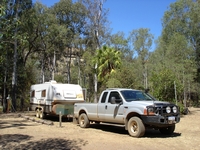
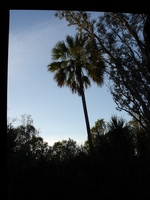
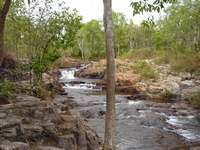
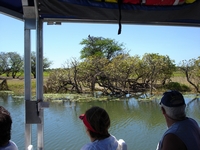
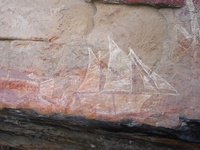
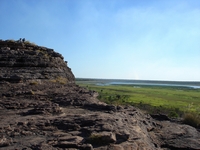
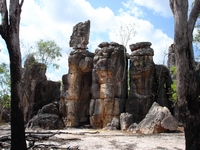
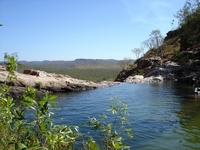
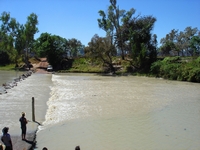
A variety of sights at Kakadu National Park
Contrasts within Litchfield National Park
For popular caravan parks, phone ahead or arrive early in the day
A. It all depends on road conditions at that time and the strength and suitability of your caravan. See the Main Roads
WA pamphlet "Driving the Gibb River Road".
While most of the vans we saw on the Gibb River Road (in 2008) were Bushtrackers,
it does depend on the road conditions at the time. We went early in the season; graders were working and the conditions were good.
It had mostly been graded when opened, then closed for a few days after June rain and graders were still working. Parts of the road
were good for a dirt road and parts average (we are used to dirt roads and corrugations). We took our time, and ran our tyres on 25
psi cold all round. Come July, with school holidays, droves of tourists in hire vehicles and other travellers driving way too fast,
the road becomes corrugated very quickly. Someone arrived in Kununurra with their Bushtracker and said it was the worst road
they had ever been on; only a week or two after we had been through. You will always find some bad patches.
Assess it
after talking to others who have just come in from it when you get to Derby or Kununurra. We met a man at a garage in Derby with
broken shockies on his Landcruiser. He’d limped into Derby for repairs from somewhere in the middle of his tour of the Gibb
River Road; this in June when the road was probably at its best. Bear in mind some will say as smooth as a baby’s and others
will say worst road ever, but listen to them all and sort the wheat from the chaff. Come July the droves of tourists, many in
hire vehicles driving much to fast and endangering other road users, make the road corrugated very quickly.
Although we
found the conditions better than many long inland roads, and compared to some of these roads, the Gibb River Road is not long in kilometres,
it is still not a journey to be taken on lightly.
Have a plan B in case conditions are less than you want to take your caravan on. Be prepared to go tenting and enjoy this wonderful place for two or three weeks or so, taking in the Mitchell Plateau and Kalumburu. Doing a loop back via the bitumen only takes two or three days, but does give you the opportunity to spent two or three days at the
must-see Purnululu where you can’t take your caravan anyway. Geikie Gorge at Fitzroy Crossing is very different to the other
gorges and worth taking the Department of Environment and Conservation boat to see the gorge – very good value. Then you have
the choice of leaving your van at Kununurra or Derby. Even if continuing on, it is only a couple of days or so of double up
travel on the highway.
Alternatives to tenting are to hire a four wheel drive camper for the trip (from either Broome or Kununurra),
or hire a camper trailer. If hiring, be sure that the vehicle is being hired for dirt road travel which will cost more than
for vehicles hired to drive exclusively on bitumen.
If you take your caravan and have a breakdown, be prepared to pay
between $10,000 and $20,000 to be recovered from remote areas. Is it worth the risk? Motoring organisation roadside assist
policies will not pay much towards large amounts. Even if all goes well, every corrugation is doing damage which will show up
eventually – maybe while you are somewhere else remote.
It is not just your driving to consider; it may of course
be the other party that runs you off the road causing damage. We came across a few hire vehicles on the Gibb River Road travelling
too fast, and bouncing all over the road as they tried to gain control as we approached. The road was wide and no collisions with
us, but a few anxious moments. We followed a tour coach one day, and he gave a short sharp comment on the two-way to drivers like
this.
There was nowhere on the Gibb River Road itself where we really needed to engage four wheel drive or needed high clearance.
It also depends on how deep the water crossings are, as they are deeper early in the season, and how this will affect your caravan.
Ours is high clearance and has a water door, although the only water I would call deep we crossed was the King Edward River on the
Mitchell Plateau Road, and that area is a very different scenario. The roads to Drysdale River Station and on to Kalumburu were different
again.
My personal advice is unless you have a top of the range dedicated off road caravan, do not to risk it; camp out, and get into
all the nooks and crannies which are more accessible when not towing.
We took three and a half weeks fromDerby to Kununurra and it was our most enjoyable trip.
2011
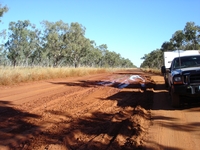
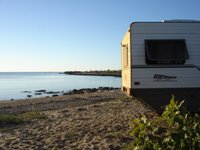
Beachside camping at McGowan's Island Campground Kalumburu; delighful for those who's rigs can handle the road to Kalumburu. Note McGowans will not be open for the 2025 season.
A sticky patch on the Gibb River Road after re-opening. June rain closed the road due to this type of damage occurring.
Questions welcomed. Please use Contact tab
Australia So Much to See
Copyright (C) 2013 AustraliaSoMuchtoSee.com. All reights reserved










